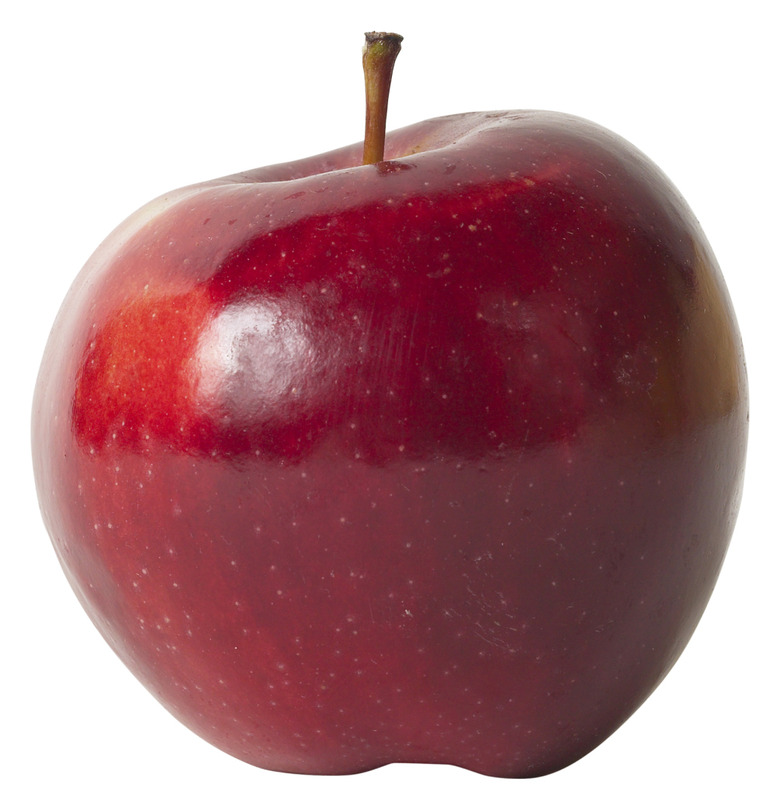Enzyme Activity In Apples
Enzymes are molecules that speed up chemical reactions in biological organisms, including plants, animals and bacteria. They are often referred to as catalysts since they spark or speed up those chemical reactions.
In apples, various enzymes are involved in the metabolic pathways that lead to growth, ripening and browning. The names of enzymes end in "ase" while the first part of the name generally refers to the initial substance on which they act to create new compounds.
Growth Processes
Enzymes in apple seeds become active once the seeds have imbibed enough water. One of the ways that they act is by their effects on hormones, which are chemical messengers that regulate development. Even when the apple is just a seed, powerful hormones are produced that give signals to initiate growth.
Enzymes are also involved in breaking down storage molecules into smaller and more easily transported components. Amylase converts starch to the sugar maltose, while proteases convert proteins into amino acids.
Becoming Softer and Sweeter
Once apples reach their full size they begin to ripen. They transform from being hard, green and somewhat tart in flavor to becoming soft and delicious fruits that animals and people want to eat. This is an evolutionary tactic to ensure the seed is carried some distance away from the parent plant.
Another hormone, ethylene, is responsible for triggering the ripening process and subsequent developmental changes. It also activates the genes for enzymes involved in the various pathways.
Enzymes Involved in Ripening
The changes associated with ripening occur with the aid of various enzymes. Amylase helps the conversion of starch into shorter sugar molecules, including fructose, glucose and sucrose, which make the apple sweeter, juicier and less grainy.
Pectinase accelerates the breakdown of pectin, a structural substance in the cell walls, which results in a softer fruit, and chlorophyllase breaks down chlorophyll, revealing red pigments underneath. Other enzymes convert large organic molecules into smaller components that evaporate and create an attractive aroma.
Apple Oxidation
Unfortunately, apples do not stay sweet and succulent forever. Sooner or later the skin becomes soft enough to bruise easily or it is cut. When this happens, oxygen enters the cells in the apple and an enzyme called polyphenol oxidase combines the oxygen with other molecules to form intermediate products known as o-quinones.
These react with amino acids to produce the distinctive brown color. Browning can be slowed by techniques such as coating the apples with sugar or lemon juice. You could perform an enzymatic browning of apples experiment by taking a bite from one and letting it site inside for a few hours.
Other Enzyme Reactions
Now that you know about enzyme activity in apples, you may be curious about how enzymes work as catalysts in other reactions. One of the most important ways enzymes work is within our own human bodies. Enzymes help to speed up the chemical reaction that happens when our digestive systems break down the food we eat, so that we can then use those calories as fuel to power our bodies.
Enzyme activity is also helpful in speeding up chemical reactions in a variety of products that you might often use or consume. For instance, many cheese makers must understand how enzymes work to produce or flavor their cheese. Other cheesemakers use the enzyme lactate to create cheese that's safe for lactose-intolerant people to eat.
You can also find enzymes in many household cleaning products. Certain enzymes can help speed up the chemical reaction that takes place to get rid of stains and grease. Understanding more about the critical role of enzymes in chemical reactions can help you understand the ways they make little and big differences in our lives every day.
Cite This Article
MLA
Smith, Clare. "Enzyme Activity In Apples" sciencing.com, https://www.sciencing.com/enzyme-activity-apples-23404/. 23 April 2019.
APA
Smith, Clare. (2019, April 23). Enzyme Activity In Apples. sciencing.com. Retrieved from https://www.sciencing.com/enzyme-activity-apples-23404/
Chicago
Smith, Clare. Enzyme Activity In Apples last modified August 30, 2022. https://www.sciencing.com/enzyme-activity-apples-23404/
